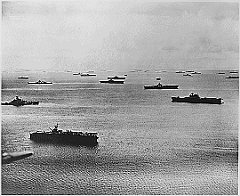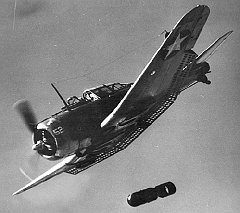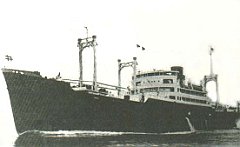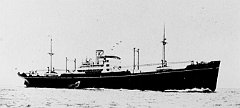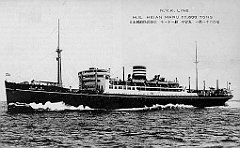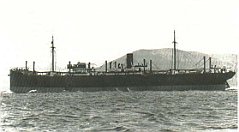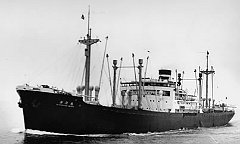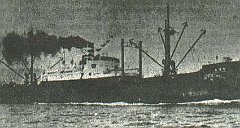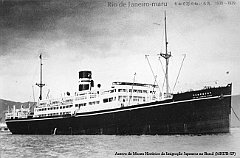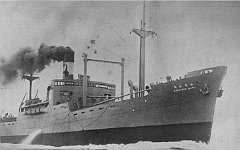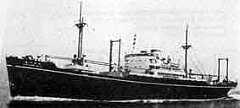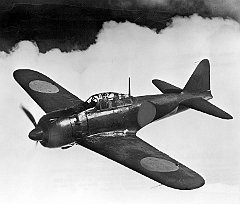|
Operation Hailstone 28 Images The U.S. attack involved a combination of airstrikes, surface ship actions, and submarine attacks over two days and appeared to take the Japanese completely by surprise. Several daylight, along with nighttime airstrikes, employed fighters, dive bombers, and torpedo aircraft in attacks on Japanese airfields, aircraft, shore installations, and ships in and around the Truk anchorage. A force of U.S. surface ships and submarines guarded possible exit routes from the island's anchorage to attack any Japanese ships that tried to escape from the airstrikes.
In total the attack sank three Japanese light cruisers (Agano, Katori, and Naka), four destroyers (Oite, Fumizuki, Maikaze, and Tachikaze), three auxiliary cruisers (Akagi Maru, Aikoku Maru, Kiyosumi Maru), two submarine tenders (Heian Maru, Rio de Janeiro Maru), three other smaller warships (including submarine chasers Ch-24 and Shonan Maru 15), aircraft transport Fujikawa Maru, and 32 merchant ships. Some of the ships were destroyed in the anchorage and some in the area surrounding Truk lagoon. Many of the merchant ships were loaded with reinforcements and supplies for Japanese garrisons in the central Pacific area. Very few of the troops aboard the sunken ships survived and little of their cargoes were recovered.
|
|
| |
|
Kensho Maru 9 Images On February 17, 1944 the passenger-cargo ship, Kensho Maru was hit on the stern by a bomb dropped by aircraft from USS Yorktown CV10. On February 18, 1944, aircraft from USS Enterprise, USS Monterey and USS Bunker Hill CV17 attacked the Kensho Maru. A torpedo hit amidships, and she promptly sank upright with a 15/20 degree list to port. The vessel was under repair at that time & there is little to be found in the holds. Many artefacts, however, can be found on the bridge & superstructure. The main attraction is the engine room which has good ambient light & is relatively easy to access.
Length: 384 ft. 116 m.
Gross Tonnage: 4,862 tons
|
|
| |
|
Fujikawa Maru 25 Images A Passenger-Cargo Ship, the Fujikawa Maru was built in 1938 and served in routes to North America, South America and India, until being taken for war use by the Japanese Navy in 1940. The ship was struck by a torpedo during Operation Hailstone Strike 3E-1 at 1420 hours by aircraft from the USS Bunker Hill and USS Monterey. She finally went down the next morning. The most popular wreck in Truk Lagoon, the Fujikawa Maru is a must dive. All the holds contain cargo and in hold #2 are the remains of 5 Zero fighter planes. The engine room is particularly interesting but requires a fairly tight squeeze in to the lower levels.
Length: 433 ft. 132 m.
Gross Tonnage: 6,938 tons
|
|
| |
|
Fumitzuki 11 Images This Mutsuki Class Destroyer built in 1926 was one of only two real Navy ships in Truk Lagoon. She was capable of over 33 knots fully loaded, but was under repair at the time of her demise, when around the middle of the day on February 17, 1944, three 500-lb bombs were dropped on her as she tried to evade. The ship was engulfed in flames and began to sink and list to port. She dropped anchors, but went down by the next morning.
Length: 320 ft. 98 m.
Gross Tonnage: 1,913 tons
|
|
| |
|
Heian Maru 27 Images The passenger-cargo ship, Heian Maru was built in 1930 at a cost of $15,000,000. On her maiden voyage she set a trans-Pacific speed record on a trip to Seattle with passengers traveling in English-style luxury. She was converted into a Navy submarine tender in 1941. On February 17, 1944 a dive bomber from the USS Yorktown CV10 hit near the bow exploding the superstructure in a fiery inferno. On the 18th two torpedo bombers from USS Bunker Hill scored near misses, but damaged the ship. The ship was then hit by Avenger torpedo bombers, which caused an explosion, sinking the ship. Now lying on its port side, its name, in both Kanji & English characters, is a great photo opportunity. Entering the forward hold, over one dozen 24 in./60 cm. diameter Long Lance torpedoes can be found. Periscopes lie in two companionways on levels below & aft of the bridge. Many artefacts can be found throughout this wreck and the engine room allows for some interesting penetration.
Length: 509 ft. 155 m.
Gross Tonnage: 11,614 tons
|
|
| |
|
Hoki Maru 14 Images The cargo ship Hoki Maru was built in 1921 for the Union Steam Ship Co. of New Zealand (Formerly M/V Hauraki) for trans-Pacific trade, mostly to Australia. In July, 1942 she was ambushed by Japanese armed merchant cruisers Hokoku Maru and Aikoku Maru and captured, with her crew sent to the horrible Ofuna POW Camp in Tokyo. On February 17, 1944 she was repeatedly attacked by USS Essex and USS Yorktown bombers and then torpedoed by planes from USS Bunker Hill CV17. She burned and sank before the next day's attacks, upright with a slight list to port. Except for the bow & forecastle the fore ship was destroyed by an aviation gasoline explosion. The midship & bridge are devastated but contain pockets of interesting artefacts. The aft holds contain an assortment of construction equipment & supplies. Caterpillar tractors, tow tractor, stack bed trucks, dump trucks, steam roller & a motor scraper are on the two levels of #5 hold. Bombs & their fuses, aircraft engines & propeller blades, ship propeller blades, navigation light lens, acid carboys & oil/gasoline drums are in #4.
Length: 450 ft./136 m.
Gross Tonnage: 7,112 tons
|
|
| |
|
Kiyosumi Maru 26 Images The passenger-cargo ship Kiyosumi Maru was built in 1934 and provided service to New York from Kobe, Japan. In 1941 she was converted into an armed auxiliary cruiser, with eight anti-aircraft guns and a pair of torpedo launchers. US Submarine Balao attacked Kiyosumi Maru with a half dozen topedoes, three of which nailed her, but she didn't go down. A sister cruiser Oyodo towed her to Truk Lagoon, where she was being repaired at the time of Operation Hailstone. Douglas dive bombers from USS Yorktown CV10 and USS Enterprise sank her and 43 crewmen died in the attacks. Now resting on the port side, most of the exterior is covered in algae and coral. There is a small lantern locker containing bronze lanterns and lantern parts on shelves. Access into the lower deck is possible through a rear entrance at deck level. China and pots have been seen on this wreck.
Length: 450 ft. 137 m.
Gross Tonnage: 3,833 tons
|
|
| |
|
Nippo Maru 29 Images The passenger-cargo ship Nippo Maru was launched in Kobe, Japan in 1936. In 1941 Nippo Maru was requisitioned by the Japanese Navy for transport. On February 17, 1944 she was at anchor, carrying water, firewood, troop armaments, a battle tank and a truck to various Pacific Islands. She was set ablaze and sunk by a trio of 500-pound bombs from TBF Avengers from the Carrier Essex. Sinking upright with a slight list to port the deck cargo consists of trucks & a battle tank forward of the bridge, with four light anti-tank guns aft. A full battery of 5 in./12 cm. guns rest in the aft hold. This has one of the most picturesque bridges in Truk. The helm & telegraph are both set well forward & provide an outstanding photo opportunity.
Length: 353 ft 106 m.
Gross Tonnage: 3,764 tons
|
|
| |
|
Rio De Janeiro Maru 50 Images Built in 1930, originally the Rio De Janeiro was a beautiful eight-deck passenger liner. Requisitioned by the Japanese Navy in 1940, she was converted into a submarine tender. On February 17, 1944 she was struck by one or two 1,000-lb bombs during the first phase of Operation Hailstone. She was seen languishing at her anchorage and sank by morning and now rests on her starboard side. She is on an incline with the stern deeper than the bow. A twin engine ship, the screws & rudder offer an excellent photo opportunity, as does the large 6 in/15 cm stern gun. The raised letter name below the stern rail is still visible. Cargo includes coastal defence guns, oil/gasoline drums and a hold of beer bottles. The engine room is large to accommodate the twin engines and makes for an exceptional penetration dive to see the workings of an engine room.
Length: 463 ft. 142 m.
Gross Tonnage: 9,626 tons
|
|
| |
|
Sankisan Maru 9 Images Captured by the Japanese in 1942, she arrived in Truk on February 12, 1944. The Sankisan Maru was bombed on both February 17 and 18, and it appears that the cargo of munitions was either struck by a bomb directly, of reached by a fire. Nevertheless it resulted in a tremendous explosion, fragmenting the entire mid-ship superstructure and flinging the whole stern section into deeper water. The holds contain aircraft engines, medical supplies & several trucks. The masts contain heavy growth of soft coral and large anemones can be found anchored to debris on the deck.
Length: 367 ft. 112 m.
Gross Tonnage: 4,776 tons
|
|
| |
|
Shinkoku Maru 42 Images Another wreck with outstanding soft coral growth and anemone, the Shinkoku Maru is high on the list of wrecks to dive! The bow gun is loaded with soft & hard coral of every color imaginable. Tiny, brightly coloured fish swarm over every inch of the ship. The bridge still holds three engine telegraphs and the sick bay contains two operating tables and many medicine bottles. The route through the engine room from the crack in the outside the hold, up and through, makes an interesting dive.
Length: 500 ft. 152 m.
Gross Tonnage: 10,020 tons
|
|
| |
|
Yamagiri Maru 39 Images Passenger-cargo ship built in 1938, she was en route to Palau in August 1943 when she was located by the submarine USS Drum, which fired two torpedoes. The ship was heavily damaged and was taken to Rabaul, New Guinea for repairs, and then to Truk. She would remain under repair for two months until Operation Hailstone. On February 18, 1944 she was struck by one 1,000-lb and one 500-lb bomb, by Curtis Helldivers from USS Bunker Hill CV17, resulting in a huge explosion and fire. She sank rapidly and is now lying on her port side. The wreck is fairly intact with the superstructure and pilot house interesting and accessible. Hold No. 5 contains 35.6cm (14") shells for second-line Japanese battleships, a steamroller and construction equipment.
Length: 439 ft. 133 m.
Gross Tonnage: 6,438 tons
|
|
| |
|
Zero Fighter 4 Images A Mitsubishi A6M5 carrier attack fighter plane given the nickname "Zero" by the Allied forces lies upside down in 60 ft (18m) of water. When it was introduced early in World War II, the Zero was the best carrier-based fighter in the world, combining excellent maneuverability and very long range. In early combat operations, the Zero gained a legendary reputation as a "dogfighter", gaining the outstanding kill ratio of 12 to 1, but by 1942, a combination of new tactics and the introduction of better equipment enabled the Allied pilots to engage the Zero on more equal terms.
|
|
| |
|
Blue Lagoon 39 Images The Blue Lagoon dive shop and resort, occupy the most prime property on the southern tip of Weno Island (formerly Moen, in the village of Neauwo). The coconut-studded spacious grounds include the island's best beaches and sunset views. A fleet of fast dive boats and knowledgeable guides provide easy access to the wrecks and allows divers the freedom to dive in small, personal groups on wrecks of their choice. The Blue Lagoon dive shop caters well for both nitrox and rebreather divers. This really is diving made very easy.
|
|
| |
| Chuuk Lagoon Slideshow
 | |
Chuuk Lagoon Slideshow Chuuk Lagoon slideshow to view as a video with a musical background.
|
| |


